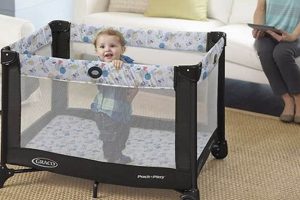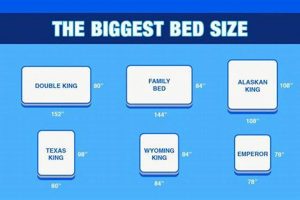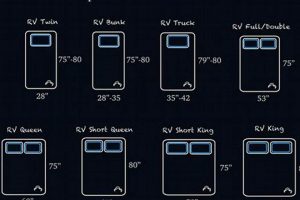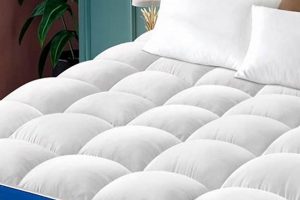Dimensions of bedding surfaces sold within Australia adhere to specific, standardized measurements. These measurements, expressed in centimeters (cm), define the length and width of the mattress and dictate the corresponding dimensions of sheets, blankets, and other bedding accessories. For example, a ‘Queen’ size is commonly 153 cm wide and 203 cm long.
Adherence to these established dimensions provides several advantages. It simplifies the purchasing process for consumers, ensures compatibility between mattresses and bedding accessories, and facilitates consistent manufacturing processes. The development of these standardized sizes reflects the evolution of the Australian bedding industry and the need for practical uniformity across different manufacturers.
The following sections will detail the specific dimensions associated with each of the standard size designations, including Single, Double, Queen, King, and Super King, providing a comprehensive guide to selecting the appropriate bedding surface.
Guidance on Selecting Bedding Dimensions
Choosing the correct bedding dimensions requires careful consideration of several factors. The following guidance offers insights to assist in selecting an appropriate size.
Tip 1: Consider Room Dimensions: Prior to purchase, accurately measure the available space within the bedroom. Factor in additional space for movement around the bed and placement of bedside furniture.
Tip 2: Assess Occupancy Needs: Single individuals generally find smaller sizes, such as Single or King Single, adequate. Couples should consider larger sizes, such as Queen or King, for increased comfort and reduced partner disturbance.
Tip 3: Evaluate Sleeper Height and Weight: Taller individuals may benefit from King or Super King sizes to accommodate their length. Individuals with larger body mass should consider Queen or King sizes for optimal support and space.
Tip 4: Investigate Bedding Availability: Ensure that sheets, blankets, and other bedding accessories are readily available in the chosen size. Some less common sizes may have limited options.
Tip 5: Check Bed Frame Compatibility: Confirm that the bed frame is designed to accommodate the selected mattress size. Mismatched frames and mattresses can lead to instability and reduced support.
Tip 6: Review Manufacturer Specifications: While standards exist, minor variations in dimensions may occur between manufacturers. Always review the specific measurements provided by the manufacturer prior to purchase.
Tip 7: Consider Future Needs: Evaluate potential changes in sleeping arrangements or lifestyle. Selecting a larger size may provide flexibility for future needs.
Adhering to these guidelines ensures that the selected bedding dimensions meet both individual comfort requirements and practical spatial considerations.
The following sections will delve into specific use cases and considerations for each of the standard sizes, further assisting in the selection process.
1. Single Dimensions
The term “Single Dimensions” references the standard length and width measurements associated with the smallest commonly available bedding surface in Australia. These dimensions are integral to the established system of sizes, impacting bedding accessory choices and room planning.
- Standard Size
The standard dimension is typically 92 cm wide and 188 cm long. This measurement is critical for bed frame compatibility and selecting appropriately sized sheets and blankets.
- Target Demographic
Single dimensions cater to individual sleepers, often children, teenagers, or adults with limited space. Understanding this target demographic helps manufacturers and retailers appropriately market and stock relevant bedding accessories.
- Space Considerations
The compact size of single dimensions makes it suitable for smaller bedrooms, studio apartments, or guest rooms where space is a premium. Its efficient use of floor area is a key advantage.
- Cost Effectiveness
Single dimensions are generally the most affordable option among standard measurements. This cost-effectiveness makes them an attractive choice for individuals on a budget or for outfitting multiple beds in shared accommodations.
The standardized measurements of a single impact the dimensions of bedroom furniture, selection of bedding, and even the overall perception of space within a room. These factors highlight the importance of considering individual needs and room constraints when selecting a bedding surface.
2. Double Measurements
Within the framework of sizes adhered to in Australia, “Double Measurements” denotes a specific set of dimensions that serve as a bridge between single and queen-sized bedding surfaces. This intermediate size is a significant consideration for individuals seeking more space than a single but require a smaller footprint than a queen.
- Defined Dimensions
The standard dimensions are typically 137 cm in width and 188 cm in length. These measurements provide a standardized benchmark for manufacturers and consumers, ensuring interchangeability and predictable sizing for bedding accessories and bed frames.
- Target User Profile
Double measurements are often selected for growing teenagers, single adults desiring more space than a single, or couples with limited bedroom space. The size offers increased sleeping area without requiring the significant spatial commitment of larger sizes.
- Spatial Efficiency
The double is well-suited to smaller bedrooms or guest rooms. Its dimensions offer a balance between sleeping comfort and efficient use of available square footage, making it a practical choice for apartments or smaller homes.
- Market Availability
Bedding accessories designed for doubles are widely available in Australia, ensuring ease of purchase and a range of style options. This accessibility contributes to the continued popularity of the double within the size spectrum.
The practical implications of the “Double Measurements” contribute significantly to its standing within the established matrix of sizes. Its ability to balance space, comfort, and availability underscores its relevance to individuals and couples navigating size choices.
3. Queen Parameters
Within the lexicon of “australian mattress sizes,” the designation “Queen Parameters” signifies a specific set of dimensional standards critical to the bedding industry and consumer experience. These parameters define the length and width of a Queen, influencing manufacturing, retail, and ultimately, consumer selection. Understanding these parameters is fundamental to comprehending the broader system of sizes employed within Australia.
- Standard Dimensions
The core of Queen Parameters lies in its established dimensions: typically 153 cm in width and 203 cm in length. These figures are the benchmarks for manufacturers, ensuring that mattresses and associated bedding accessories are compatible. Departures from these dimensions, even slight, can lead to issues with fit and consumer dissatisfaction. For example, sheets designed for a standard Queen may not properly fit a mattress that deviates from these dimensions.
- Market Dominance
Queen Parameters are particularly relevant due to the Queen’s position as one of the most popular sizes. Its prevalence in the market impacts manufacturing priorities, retail strategies, and consumer awareness. The ubiquity of the Queen means that manufacturers often prioritize its production, while retailers dedicate significant floor space to Queen-sized products. Consequently, consumers are typically more familiar with Queen dimensions compared to less common sizes.
- Sleep Partner Compatibility
Queen Parameters are designed to accommodate two adults comfortably. Its width provides sufficient space for each sleeper, minimizing disturbance and promoting restful sleep. In contrast to smaller sizes like Double, the Queen offers a tangible improvement in sleeping space for couples, making it a preferred choice when room size permits.
- Bed Frame and Accessory Standards
The defined measurements ensure that bed frames and accompanying accessories adhere to certain standards. The internal dimensions of a Queen bed frame, for instance, are specifically designed to accommodate a mattress conforming to the Queen Parameters. This interconnectedness facilitates seamless integration between the mattress and its supporting structure, enhancing stability and longevity.
The facets of Queen Parameters, from its standardized dimensions to its influence on market dynamics and consumer behavior, underscore its pivotal role within the landscape of “australian mattress sizes.” Recognizing these parameters is crucial for making informed decisions, whether in manufacturing, retail, or as a consumer seeking a comfortable and well-fitting bedding arrangement.
4. King Specifications
Within the established framework of “australian mattress sizes,” “King Specifications” denotes a distinct set of dimensional standards crucial to the design, manufacture, and consumer selection processes. These specifications are essential for ensuring compatibility with bedding accessories and bed frames and providing a comfortable sleeping surface for one or more individuals.
- Dimensional Standards
King Specifications are defined by standardized measurements, typically 183 cm in width and 203 cm in length. These dimensions dictate the physical footprint of the and are foundational for the design of accompanying bedding, such as sheets, blankets, and mattress protectors. Departures from these established dimensions, even minor variations, can result in incompatibility with standard bedding accessories and compromise user satisfaction.
- Target Demographic and Use Cases
King Specifications cater to individuals and couples who prioritize ample sleeping space. The increased width is particularly beneficial for couples who prefer to avoid disturbing each other during sleep. Furthermore, this size is suitable for individuals who desire additional room to stretch out or for families who occasionally co-sleep with children. The market availability of King-sized mattresses and bedding reflects this demand.
- Spatial Requirements
The adoption of King Specifications necessitates careful consideration of bedroom dimensions. Due to the expansive footprint, a King requires a larger room to ensure comfortable movement and placement of other furniture. Inadequate space can result in a cramped and uncomfortable environment. Prior to purchasing, consumers should accurately measure their bedroom and consider the placement of bedside tables and other essential furniture items.
- Bed Frame and Support Systems
King Specifications necessitate the use of appropriately designed bed frames and support systems. The frame must provide adequate support to prevent sagging and ensure proper weight distribution. Many frames designed for Kings incorporate a central support beam to enhance stability. Selecting a compatible and robust frame is crucial for maximizing mattress lifespan and ensuring sleeper comfort.
Consideration of King Specificationsincluding dimensional standards, target demographics, spatial requirements, and bed frame compatibilityis critical for consumers within the “australian mattress sizes” market. A thorough understanding of these specifications ensures appropriate product selection and maximizes the benefits of a King-sized sleeping surface.
5. Super King Values
The designation “Super King Values” within the Australian market for bedding surfaces refers to a specific set of dimensions exceeding those of a standard King. These increased dimensions, typically 203cm by 203cm, represent a considerable expansion in sleeping area. The values associated with this increased size directly impact consumer choice and manufacturing considerations within the broader “australian mattress sizes” landscape. For example, couples prioritizing individual space or those with children and pets sharing the bed may find the additional width a necessity, directly influencing their purchasing decision. The practical effect is a requirement for larger bedrooms to accommodate the footprint.
The significance of “Super King Values” extends beyond mere dimensions. It embodies a commitment to comfort and luxury, reflecting the evolving consumer demand for enhanced sleep experiences. Manufacturers respond by allocating resources to produce larger sizes, impacting inventory management and pricing strategies. Furthermore, the availability of accessories, such as appropriately sized sheets and bed frames, is directly linked to the perceived value of a Super King. If consumers struggle to find compatible bedding, the value proposition diminishes. Real-world examples include specialized linen retailers catering specifically to larger or less common bedding sizes.
In summary, “Super King Values” represent a tangible expression of prioritizing space and comfort within “australian mattress sizes.” This increased size directly affects purchasing decisions, bedroom spatial requirements, and the availability of compatible accessories. Understanding these values is crucial for both consumers seeking optimal sleep arrangements and manufacturers adapting to evolving market demands. The challenge remains in balancing the perceived benefits of a larger sleeping surface with practical considerations like cost and spatial constraints, shaping the future trajectory of bedding dimensions within Australia.
6. Depth Variability
Depth variability in mattresses constitutes a significant, often overlooked, dimension within the landscape of “australian mattress sizes.” While length and width are commonly emphasized, variations in mattress depth impact the overall fit of bedding accessories and the perceived comfort level. This variation necessitates careful consideration when selecting sheets and other bedding components.
- Sheet Fit Implications
Mattress depth directly affects the required pocket depth of fitted sheets. A shallow sheet pocket may not adequately cover a deep mattress, leading to slippage and discomfort. Conversely, an excessively deep pocket on a thinner mattress can result in a loose and wrinkled fit. For example, a pillow-top mattress requires sheets with significantly deeper pockets than a standard innerspring mattress. Failure to account for depth variability can result in ill-fitting and unsatisfactory bedding arrangements. This is most critical in cases where custom mattresses are created.
- Bed Frame Compatibility
Mattress depth influences the overall height of the bed, which, in turn, affects ease of entry and exit. A particularly deep mattress, when combined with a high bed frame, can create an excessively elevated sleeping surface, posing challenges for individuals with mobility issues. Conversely, a thin mattress on a high frame may result in an uncomfortably low sleeping surface. Bed frame dimensions, therefore, must be carefully considered in conjunction with mattress depth to achieve an optimal and accessible bed height.
- Impact on Support and Comfort
While not directly determining size, mattress depth often correlates with the internal layering and construction of the mattress. Thicker mattresses frequently incorporate multiple layers of foam, springs, or other materials designed to enhance support and comfort. However, depth alone does not guarantee superior performance. The quality and arrangement of internal materials are equally important. Consumers should evaluate the overall construction and material composition in addition to simply considering depth as a metric for quality. A deeper mattress might be more supportive than a thinner mattress if the material composition warrants it, however this is not always true.
- Industry Standards and Measurement Practices
While length and width adhere to relatively strict standards, depth measurements may exhibit greater variability across different manufacturers. Consumers should consult the manufacturer’s specifications to obtain accurate depth measurements prior to purchasing bedding accessories. Industry standards provide guidelines for dimensional tolerances, but slight variations are common. Reputable manufacturers typically provide detailed product information, including precise depth measurements, to facilitate informed consumer decision-making and reduce the likelihood of compatibility issues.
In conclusion, depth variability represents a critical yet often overlooked dimension within the context of “australian mattress sizes.” Its impact on sheet fit, bed frame compatibility, support characteristics, and industry measurement practices underscores the need for careful consideration. Consumers are advised to prioritize accurate depth measurements and evaluate mattress construction holistically to ensure optimal comfort and satisfaction.
Frequently Asked Questions
The following section addresses common inquiries regarding the dimensions of bedding surfaces sold within Australia. Adherence to standardized measurements is essential for compatibility and consumer satisfaction. The subsequent questions and answers provide clarity on key aspects related to sizes and their implications.
Question 1: Are stated dimensions perfectly uniform across all manufacturers?
While industry standards exist, slight variations may occur between different manufacturers. Consumers are advised to consult the specific product specifications provided by the manufacturer prior to purchase to ensure compatibility with existing bed frames and bedding accessories.
Question 2: What is the generally accepted tolerance for dimensional variation?
A tolerance of approximately 1-2 centimeters is generally considered acceptable. However, significant deviations from stated dimensions should be addressed with the retailer or manufacturer.
Question 3: How does mattress depth influence the selection of appropriate sheet sizes?
Mattress depth directly correlates with the required pocket depth of fitted sheets. Deep mattresses necessitate sheets with correspondingly deep pockets to ensure a secure and proper fit. Failure to account for mattress depth may result in sheets that are too small or too large.
Question 4: What are the standard dimensions for a King Single?
The standard measurements are typically 107 cm wide and 203 cm long, offering additional length compared to a standard Single.
Question 5: Is it possible to obtain customized dimensions?
Certain manufacturers offer the option of creating mattresses with customized dimensions. However, this typically incurs additional costs and may limit the availability of compatible bedding accessories.
Question 6: What factors should be considered when selecting a size for two adults?
For two adults, Queen or King are generally recommended to ensure adequate space and minimize partner disturbance. Room size, individual sleep preferences, and budget are important factors to consider.
Selecting the appropriate bedding dimensions requires careful consideration of individual needs and spatial constraints. It is recommended to consult product specifications and measure available space prior to making a purchase.
The next section will summarize the key takeaways regarding Australian mattress sizes discussed throughout this article.
Conclusion
This exploration of Australian mattress sizes has underscored the importance of standardized dimensions within the bedding industry. From the compact Single to the expansive Super King, each size serves a distinct purpose and caters to varying needs. Accurate understanding of these dimensions, including depth variations, is crucial for consumers seeking optimal comfort and compatibility, and for manufacturers maintaining consistent product offerings.
The data presented illuminates the necessity of informed purchasing decisions, prompting a renewed focus on detailed product specifications and accurate spatial assessment. As consumer demands evolve, adherence to dimensional standards remains paramount in ensuring both satisfaction and seamless integration within the broader bedding ecosystem.







